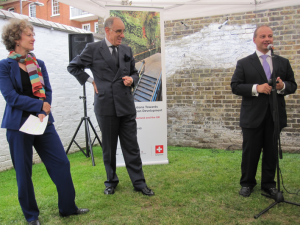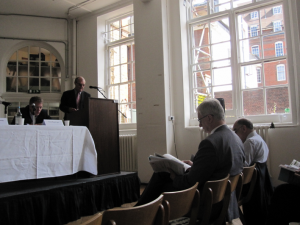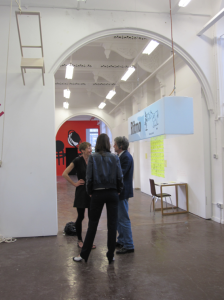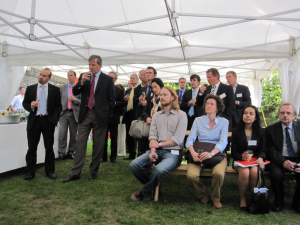Open Cities 22 Sustainability and Openness
Like other leaders of cultural institutions – Elmar Brandt when he led the Goethe-Institute in London in the early eighties, or Mike Hardy, leader of the intercultural dialogue programme of the British Council at present, the Swiss Ambassador to London, Alexis Lautenberg, is fascinated by cities. He established a Swiss – UK Dialogue on urban sustainability to explore whether urban sustainability is a contradiction in terms.

1 dia Swiss Ambassador Alexis Lautenberg with Corine Mauch Mayor of Zuerich and Deputy Mayor of London Simon Milton
‘Sustainability’ is one of the big contemporary themes. It embraces a large, some would say an ambiguous range of meanings. ‘Openness’ is another broad notion in the centre of attention of the globalising world.
It may be equally pertinent to ask whether sustainable cities and open cities are contradictory or compatible terms.
Contradiction in Terms or Symbiotic Notions?
Sustainability implies the combination of economic, social and environmental virtues in harmony with finite planetary resources and future generations. Sustainable cities are supposed to provide the material setting for sustainable living, working, playing and learning. Openness implies inclusion of all peoples, regardless of origin, race, gender, class, culture and much more in a shared space. Open cities are supposed to fulfil the conditions for such harmonious cohabitation of diversity. It could be argued that ‘good cities’ are those which satisfy both the conditions of sustainability and openness.
A publication (A Swiss-UK Dialogue, Urban Sustainability: A Contradiction in Terms?. 2010. Swiss Embassy London) and a conference (held at the A Foundation in London on 17 June 2010) looked at the ‘point of convergence’ of a wide range of sustainability issues: the city. Similarly, the British Council is currently examining the key issues of open cities globally: understanding open cities, leadership and governance of open cities, internationalisation of open cities, and managing diversity of open cities (see Open Cities Newsletter for details).

2 dia A-Foundation in an old school building of East London, a pertinent location for investigating a contradiction in terms
Sustainability understood in a systemic, generic sense encompasses the notion of steering (leadership or governance being specific instruments of such intervention), universality (referring to our planet and by definition related to the notion of internationality), and diversity (the make up of cosmopolitan cities in a global world and precondition of ecological survival).
Seeking to understand such complex and interactive processes is a precondition of wilful steering which is the ultimate object of interest of both the British Council’s Open Cities initiative and the Swiss-UK Dialogue on Urban Sustainability to which political leaders were invited, together with scientists, technologists, planners, practitioners and academics.
The speakers of the Swiss-UK Dialogue addressed governance and decision making, sustainable urban planning, design for wellbeing, and sustainable urban infrastructure. Like the Urban Cities programme, this dialogue aimed to establish the state of the art of understanding from which politicians and practitioners can learn for their decision making.
Here are some congruences between the sustainability dialogue and the open cities debate. For Alexis Lautenberg urban sustainability presupposes open spaces to facilitate social aggregation while preserving diversity in freedom of expression (p2). Referring to the social dimension of sustainability, the Federal Councillor Moritz Leuenberger mentioned that problems of integration of foreign residents are concentrated in cities, akin to unequal effects of reducing energy consumption by two thirds approved by popular vote (p3).
In Switzerland meeting ecological, political and demographic challenges means, inter alia, resorting to new localism with all its potential contradictions with openness. Boris Johnson sees sustainability in green terms, meaning carbon trading and clean technologies boosted by private venture capital generating ‘green collar’ jobs. Changing human behaviour or using the city differently is not on the agenda (pp10-11). Conversely, for the mayor of Zuerich, Corine Mauch, sustainability is a necessary condition for peaceful social coexistence (p13). She sees a worldwide shared future for her city but feels that cities do not have their rightful place at the global table of decision making. A more critical and nuanced view comes from Roland Schulz, a representative of footloose cosmopolitan open society, who considers that Swiss cities have managed to avoid the worst pitfalls of exclusion but remain in conflict with nature through sprawl, a challenge for designers and participatory cooperative planning to produce cities where a wide variety of people choose to live closely together. Mutual transdisciplinary learning between science and society can assist, but consensus achieved through socially robust knowledge is seen as the ultimate solution for multicultural cohabitation and thus openness (p18-19).
The ultimate wisdom about urban sustainability and openness comes from the philosophers. Alain de Bottom sees urban wellbeing through the looking glass of loneliness and ugliness, while his discussant Hans-Ulbricht Obrist refers to Cedric Price as the proponent of indeterminate, ephemeral and ultimately a-material interventions in cities to ‘heal’ cities and reintroduce community. Salons could be places of public encounters to bridge the barriers between sectoral interests. Cities are also the places where negotiation between the past, the future and the present takes place (pp 22-26). Passegeatas or flaner are de Bottoms remedies to overcome loneliness and reconnect with fellow citizens. Sustainable cities would be those which provide such spaces and places. For Obstrist, the shrine of friendship needs also interior complexity like in the Soames Museum in London. Cities command communal action but only with a vocabulary which can carry a huge number of people says de Bottom. Cities are the promise of the unknown, of new connections, using technology, new thinking, creativity and innovation to create structures that allow this promise to survive.
Finally for Martin R Dean in his essay dedicated to Paul Nizon (p62-63) London is still a drug for life addicts, promising a better, faster, happier life attracting people from all walks of life continuously, s model for cities all over the world. European ‘mother cities’ of former empires are experienced in dealing with foreigners and are laboratories for the future. They possess sufficient historical substance to resist the erosive process of globalisation. So the sustainable, the open city may not (yet?) be the global city after all.


